#Jacquiline Kehoe
Explore tagged Tumblr posts
Text
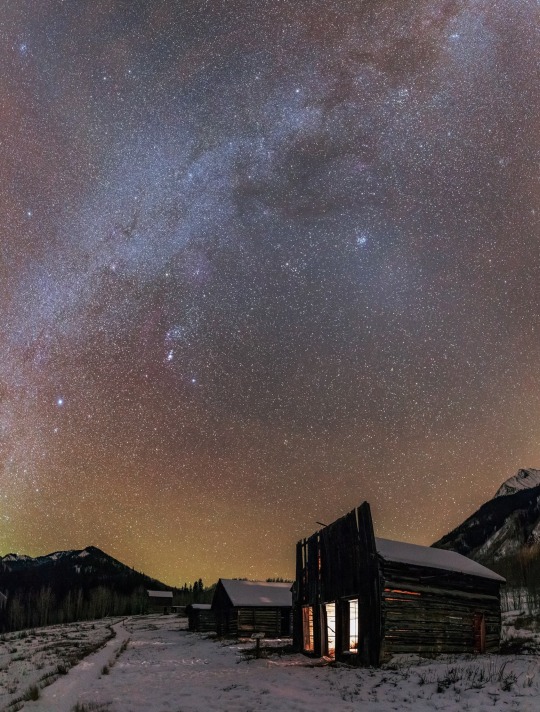
An abandoned building in the historic mining town of Ashford, Colorado, serves as the backdrop for stargazing. Hosted by the National Park Service, dark sky events are one way to help preserve public parks. Photograph By Babak Tafreshi, National Geographic Image Collection
Some U.S. National Parks Are Trying To Go Carbon-Free. What Does That Mean For Visitors?
U.S. National Parks are more climate-forward than ever. Discover ways you can support their mission.
— By Jacquiline Kehoe | August 4, 2023
Visiting at night and taking free public transportation are just two of the ways the National Park Service is encouraging visitors to go green.
In the early 2000s, NPS set out to address its environmental impact head-on. The first Green Parks Plan sought to answer big-picture questions: How can our national parks become Carbon-Neutral? Where do park emissions come from? Who or what accounts for the parks’ sizable carbon footprint?
Time and again, the answer? Visitors.
At Great Smoky Mountains National Park, guest transportation emissions—the park’s main greenhouse-gas offender—were 157 times greater than park operations. At Everglades, vehicle and watercraft use by travelers accounted for 86 percent of mobile combustion, the largest emissions-producing sector.
The NPS is now on its third iteration of the Green Parks Plan, released in early 2023. It’s the most robust version yet—goals include reducing greenhouse gas emissions to near zero, eliminating landfill waste, and investing in renewable energy. But the facts haven’t changed: these fragile landscapes need more from us.
“It’s essential to recognize that the national parks belong to the people and that people have an impact on our natural resources,” says NPS spokesperson Dave Barak. Without visitor support, in-park sustainability measures can only go so far. Working together, says Barak, “will allow NPS far more success in preserving and safeguarding these natural treasures than we could ever achieve without [visitor] support.”
Of course, most national parks seem purpose-built for a great American road trip. But that’s slowly changing. At the national parks below, exciting climate initiatives are afoot. All you have to do to help is skip the rental car.
Great Smoky Mountains National Park Lake Superior parks
In January 2023, the National Parks of Lake Superior Foundation announced that all five park units on America’s largest lake—the fastest-warming lake in the world—will go carbon-free. Isle Royale National Park, Pictured Rocks National Lakeshore, Keweenaw National Historical Park, Grand Portage National Monument, and Apostle Islands National Lakeshore are transitioning to electric equipment and transport, investing in solar and battery energy storage systems (BESS), and retrofitting all buildings to energy-efficient standards.
Great Smoky Mountains National Park—routinely the most visited national park in the country—has a vision problem. Thanks to human-caused pollution from within and around the area, such as burning fossil fuels, overflowing parking lots, and traffic jams, those famed “smoky” views are now smoggy. This haze has reduced the park’s visibility from 93 miles to 25 miles.
To tackle the issue, the park has paired with seven local shuttle companies to reduce congestion.
From Gatlinburg, Bryson City, and several other cities in Tennessee and North Carolina surrounding the wilderness area, visitors can book round-trip transfers to popular spots like Alum Cave Trail, Laurel Falls Trail, and Clingmans Dome, without worrying about parking and idling in traffic. Some providers also offer services to Pisgah, Nantahala, and Cherokee national forests for further adventures.
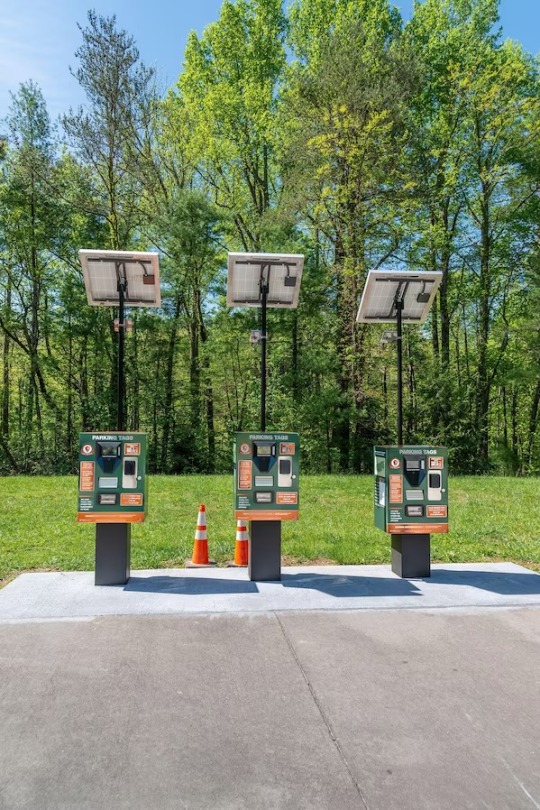
Great Smoky Mountains National Park, revenue from parking tags sold via solar-powered vending machines (pictured) go toward improving the park’s trails, custodial services, and education. Photograph By Carolyn Franks/Alamy
Lake Superior Parks
In January 2023, the National Parks of Lake Superior Foundation announced that all five park units on America’s largest lake—the fastest-warming lake in the world—will go carbon-free. Isle Royale National Park, Pictured Rocks National Lakeshore, Keweenaw National Historical Park, Grand Portage National Monument, and Apostle Islands National Lakeshore are transitioning to electric equipment and transport, investing in solar and battery energy storage systems (BESS), and retrofitting all buildings to energy-efficient standards.
Visitors can support the region’s goals by opting for the parks’ signature “silent adventures.” Kayak along the red rocks of Apostle Islands from Meyers Beach; go wilderness camping among the dense forests of Isle Royale; or hike the 8.5-mile Grand Portage Trail, an Anishinaabe canoe route, to the campsites at Fort Charlotte.
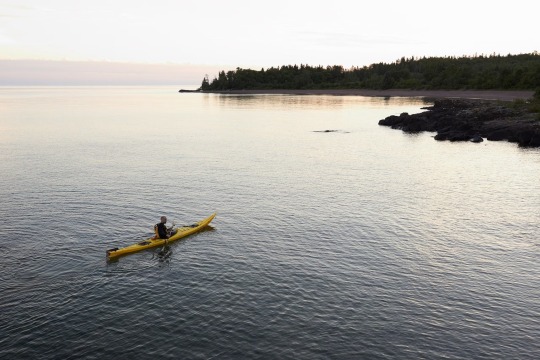
A kayaker paddles across Lake Superior from Apostle Islands National Lakeshore, in Wisconsin, one of the various “silent adventures” offered around the lake. Photograph By David Bowman, National Geographic Image Collection
Alaska Parks
The face of Alaska is changing: At Denali National Park, a landslide—induced by permafrost thaw—has cut the park’s 92-mile road by half. Visitors to Kenai Fjords National Park could once touch Exit Glacier, but now it is a distant photograph. Whale populations are down some 58 percent at Glacier Bay National Park.
Beyond learning about the Alaska park’s zero-landfill goals and a new cruise-ship inspection program, visitors are encouraged to join immersive programs about climate-change education via ranger talks and science-focused tours. For example, on the hike to Kenai’s Exit Glacier, visitors will see signs marking the glacier’s retreating path, starting from 1917 to 2010.
Denali and Kenai visitors can skip the rental car by taking the Alaska Railroad out of Anchorage Airport, north to Denali National Park. Therem they can take a bus tour, hike designated trails, and camp. For Kenai, ride the rails south to Seward, where you can hop on a fjord tour—choose an Adventure Green Alaska-certified outfitter like Kenai Fjords Tours—or overnight off-grid at Kenai Fjords Wilderness Lodge, kayaking from your waterfront door.
In Glacier Bay, the rental car isn’t an option—more than 95 percent of visitors arrive via cruise ship. But, travelers can choose a smaller cruise line like Lindblad Expeditions or Alaskan Dream Cruises, a local-owned cruise line, to better take in the state’s vast wildness.
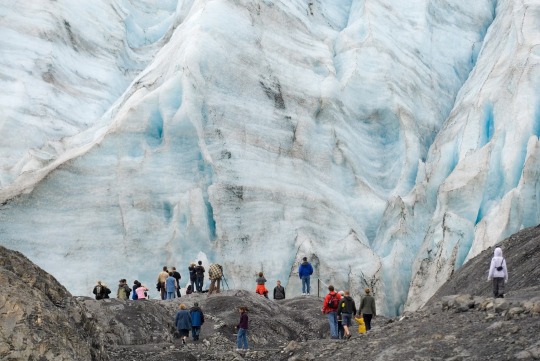
Visitors explore Exit Glacier in Alaska’s rugged Kenai Fjords National Park. The site acts as a real-time study of glacial retreat, with interpretive signs showing where the ice once extended. Photograph By Rich Reid, National Geographic Image Collection
Everglades National Park
After back-to-back hurricanes in 2005 and then again in 2007, Everglades National Park was forced to adapt. Flamingo, the visitor center at the southernmost tip of the Florida Peninsula, has been redesigned with climate-adaptable features. Repurposed and elevated steel shipping containers comprise the new Flamingo Lodge & Restaurant. The Guy Bradley Visitor Center—which once flooded up to 10 feet—has also been elevated and rebuilt to withstand the area’s now common storm surges.
Visitors looking to abandon the rental car should take advantage of the Homestead Trolley, which gets its riders free entrance into Everglades (and Biscayne National Park). As a result of a 2008 study that called for reducing visitor emissions, the trolley now runs from November to April, from Homestead to the Ernest F. Coe Visitor Center and Royal Palm/Anhinga Trail.
For an overnight Everglades experience, try the park’s new eco-tents. Roughly 100 feet from Florida Bay, their removable walls are built on elevated platforms. Sit back and watch roseate spoonbills and ospreys from your patio, or rent kayaks at the nearby Flamingo Marina and head out on the water. If you’re a serious paddler, camp overnight on one of the park’s chickees like it’s your own private island (albeit a wooden one).
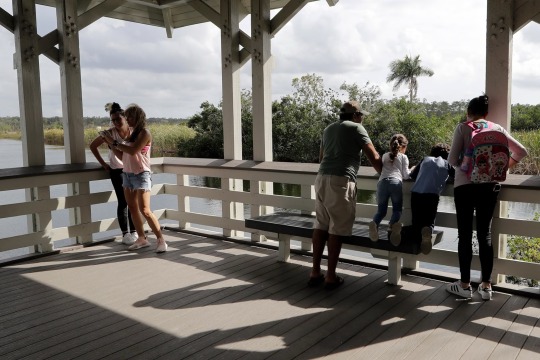
Visitors look out at the wetlands outside the Ernest F. Coe Visitor Center in Florida’s Everglades National Park. From November to April, you can reach the center via an environmentally friendly trolley from Homestead. Photograph By Lynne Sladky/AP
Grand Canyon and Grand Canyon West
Grand Canyon West, famed for its see-through skywalk, is going 100 percent solar. Under the purview of the Hualapai Tribe, the area’s existing diesel-energized power grid will be supported with a new clean, renewable solar energy field and battery storage system.
Its NPS counterpart, Grand Canyon National Park is also busy innovating. Beyond an increase in LEED-certified facilities, visitors can skip the long entrance lines by cycling into the park via the Grand Canyon Greenway Trail. The 6.5-mile gradually rises from Tusayan, Arizona, to the Grand Canyon Visitor Center. From there, cyclists can double that distance on the South Rim.
The bike-friendly Tusayan shuttle flits between the visitors center and the greenway’s trailhead for a one-way ride. With plenty of parking, non-cyclists can leave their cars and take advantage of the shuttle as well.
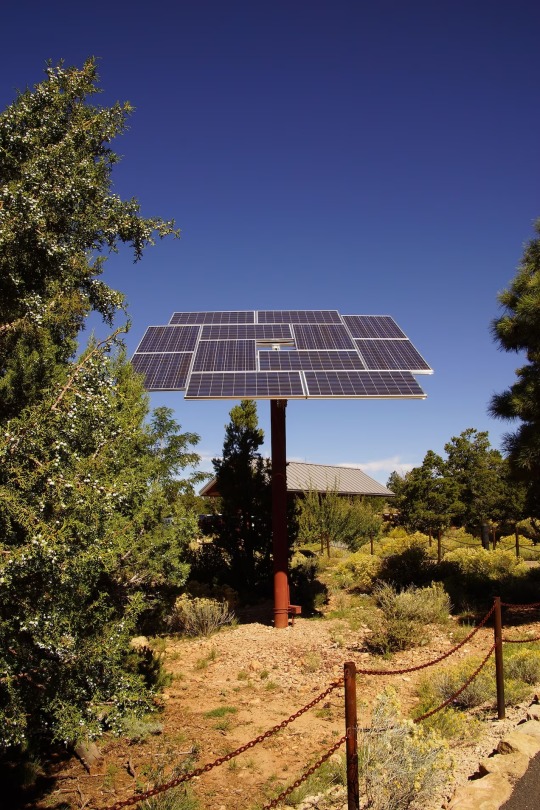
National Park, Arizona. Photograph By Cascoly/ALAMY
Colorado Parks
Colorado’s fight for a greener world has an interesting bent: much of it happens at night. Five national parks and monuments in the Centennial State are designated International Dark Sky parks, where light pollution is regulated, and the Milky Way still illuminates. Robust night programming at each park—like ranger tours and night-sky festivals—aims to decrease daytime visitation and educate visitors on how dark skies are necessary to us, wildlife, and our planet.
The only Colorado national park not designated as an International Dark Sky Park is Rocky Mountain. Travelers can reduce the popular park’s congestion (and brighten its skies) by utilizing the free Estes Park Hiker Shuttle. Riding from town to the Estes Park Visitor Center, visitors can transfer to the Bear Lake or Moraine Park shuttles to get to their trailhead or campground of choice—and wander this alpine landscape without leaving a trace.
— Jacqueline Kehoe is a Freelance Writer and Photographer from the Midwest.
#U.S. 🇺🇸 National Parks 🏞️#Carbon-Free#National Park Service#Green Parks Plan#Carbon-Neutral#Jacquiline Kehoe#The National Geographic#Zero Gas Emissions#Dave Barak#NPS
0 notes